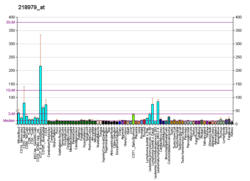RMI1
RecQ-mediated genome instability protein 1 is a protein that in humans is encoded by the RMI1 gene.[5][6]
Meiosis
During meiosis in budding yeast Saccharomyces cerevisiae, TOP3 (a type I topoisomerase) and its accessory factor RMI1 form a heterodimer that functions to allow passage of one DNA single strand through another. The TOP3-RMI1 heterodimer associates with Sgs1 (Bloom helicase ortholog) to form a complex that catalyzes dissolution of double Holliday junctions.[7] Furthermore, the TOP3-RMI1 heterodimer participates in all meiotic recombination functions associated with Sgs1, most significantly as an early recombination intermediate chaperone, promoting regulated crossover and non-crossover recombination and preventing accumulation of aberrant recombination intermediates.[8] In particular, the TOP3-RMI1–SGS1 complex promotes early formation of non-crossover recombinants during meiosis.[8]
References
- GRCh38: Ensembl release 89: ENSG00000178966 - Ensembl, May 2017
- GRCm38: Ensembl release 89: ENSMUSG00000035367 - Ensembl, May 2017
- "Human PubMed Reference:". National Center for Biotechnology Information, U.S. National Library of Medicine.
- "Mouse PubMed Reference:". National Center for Biotechnology Information, U.S. National Library of Medicine.
- Yin J, Sobeck A, Xu C, Meetei AR, Hoatlin M, Li L, Wang W (May 2005). "BLAP75, an essential component of Bloom's syndrome protein complexes that maintain genome integrity". EMBO J. 24 (7): 1465–76. doi:10.1038/sj.emboj.7600622. PMC 1142546. PMID 15775963.
- "Entrez Gene: RMI1 RMI1, RecQ mediated genome instability 1, homolog (S. cerevisiae)".
- Bizard AH, Hickson ID (2014). "The dissolution of double Holliday junctions". Cold Spring Harb Perspect Biol. 6 (7): a016477. doi:10.1101/cshperspect.a016477. PMC 4067992. PMID 24984776.
- Kaur H, De Muyt A, Lichten M (2015). "Top3-Rmi1 DNA single-strand decatenase is integral to the formation and resolution of meiotic recombination intermediates". Mol. Cell. 57 (4): 583–94. doi:10.1016/j.molcel.2015.01.020. PMC 4338413. PMID 25699707.
Further reading
- Strausberg RL, Feingold EA, Grouse LH, et al. (2003). "Generation and initial analysis of more than 15,000 full-length human and mouse cDNA sequences". Proc. Natl. Acad. Sci. U.S.A. 99 (26): 16899–903. doi:10.1073/pnas.242603899. PMC 139241. PMID 12477932.
- Meetei AR, de Winter JP, Medhurst AL, et al. (2003). "A novel ubiquitin ligase is deficient in Fanconi anemia". Nat. Genet. 35 (2): 165–70. doi:10.1038/ng1241. PMID 12973351.
- Ota T, Suzuki Y, Nishikawa T, et al. (2004). "Complete sequencing and characterization of 21,243 full-length human cDNAs". Nat. Genet. 36 (1): 40–5. doi:10.1038/ng1285. PMID 14702039.
- Humphray SJ, Oliver K, Hunt AR, et al. (2004). "DNA sequence and analysis of human chromosome 9". Nature. 429 (6990): 369–74. doi:10.1038/nature02465. PMC 2734081. PMID 15164053.
- Suzuki Y, Yamashita R, Shirota M, et al. (2004). "Sequence Comparison of Human and Mouse Genes Reveals a Homologous Block Structure in the Promoter Regions". Genome Res. 14 (9): 1711–8. doi:10.1101/gr.2435604. PMC 515316. PMID 15342556.
- Gerhard DS, Wagner L, Feingold EA, et al. (2004). "The Status, Quality, and Expansion of the NIH Full-Length cDNA Project: The Mammalian Gene Collection (MGC)". Genome Res. 14 (10B): 2121–7. doi:10.1101/gr.2596504. PMC 528928. PMID 15489334.
- Wu L, Bachrati CZ, Ou J, et al. (2006). "BLAP75/RMI1 promotes the BLM-dependent dissolution of homologous recombination intermediates". Proc. Natl. Acad. Sci. U.S.A. 103 (11): 4068–73. doi:10.1073/pnas.0508295103. PMC 1449647. PMID 16537486.
- Raynard S, Bussen W, Sung P (2006). "A double Holliday junction dissolvasome comprising BLM, topoisomerase IIIalpha, and BLAP75". J. Biol. Chem. 281 (20): 13861–4. doi:10.1074/jbc.C600051200. PMID 16595695.
- Olsen JV, Blagoev B, Gnad F, et al. (2006). "Global, in vivo, and site-specific phosphorylation dynamics in signaling networks". Cell. 127 (3): 635–48. doi:10.1016/j.cell.2006.09.026. PMID 17081983.
- Bussen W, Raynard S, Busygina V, et al. (2007). "Holliday junction processing activity of the BLM-Topo IIIalpha-BLAP75 complex". J. Biol. Chem. 282 (43): 31484–92. doi:10.1074/jbc.M706116200. PMID 17728255.
- Broberg K, Höglund M, Gustafsson C, et al. (2008). "Genetic variant of the human homologous recombination-associated gene RMI1 (S455N) impacts the risk of AML/MDS and malignant melanoma". Cancer Lett. 258 (1): 38–44. doi:10.1016/j.canlet.2007.08.005. PMID 17900800.





